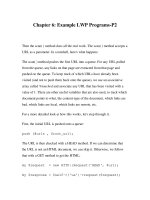Chapter 6 v7 01
Bạn đang xem bản rút gọn của tài liệu. Xem và tải ngay bản đầy đủ của tài liệu tại đây (2.66 MB, 98 trang )
©1996-2016, J.F Kurose and K.W. Ross
Computer Networks
Lectured by:
Nguyen Le Duy Lai
()
Computer
Networking: A Top
Down Approach
7th Edition, Global Edition
Jim Kurose, Keith Ross
Pearson
April 2016
The Link Layer and LANs
6-1
©1996-2016, J.F Kurose and K.W. Ross
Chapter 6
The Link Layer
and LANs
Computer
Networking: A Top
Down Approach
7th Edition, Global Edition
Jim Kurose, Keith Ross
Pearson
April 2016
Link Layer and LANs 6-2
Chapter 6: Link layer and LANs
our goals:
▪ understand principles behind link layer services:
â1996-2016, J.F Kurose and K.W. Ross
ã
ã
ã
ã
error detection, correction
sharing a broadcast channel: multiple access
link layer addressing
local area networks: Ethernet, VLANs
▪ instantiation, implementation of various link
layer technologies
Link Layer and LANs 6-3
©1996-2016, J.F Kurose and K.W. Ross
Link layer, LANs: outline
6.1 introduction, services 6.5 link virtualization:
MPLS
6.2 error detection,
correction
6.6 data center
networking
6.3 multiple access
protocols
6.7 a day in the life of a
web request
6.4 LANs
•
•
•
•
addressing, ARP
Ethernet
switches
VLANS
Link Layer and LANs 6-4
Link layer: introduction
©1996-2016, J.F Kurose and K.W. Ross
terminology:
▪ hosts and routers: nodes
▪ communication channels that
connect adjacent nodes along
communication path: links
• wired links
• wireless links
• LANs
▪ layer-2 packet: frame,
encapsulates datagram
data-link layer has responsibility of
transferring datagram from one node
to physically adjacent node over a link
Link Layer and LANs 6-5
©1996-2016, J.F Kurose and K.W. Ross
Link layer: context
▪ datagram transferred by
different link protocols over
different links:
• e.g., Ethernet on first
link, frame relay on
intermediate links,
802.11 on last link
▪ each link protocol provides
different services
• e.g., may or may not
provide reliable data
transfer (rdt) over link
transportation analogy:
▪ trip from Princeton to Lausanne
• limo: Princeton to JFK
• plane: JFK to Geneva
• train: Geneva to Lausanne
▪ tourist = datagram
▪ transport segment =
communication link
▪ transportation mode = link
layer protocol
▪ travel agent = routing
algorithm
Link Layer and LANs 6-6
Link layer services
▪ framing, link access:
• encapsulate datagram into frame, adding header, trailer
• channel access if shared medium
• “MAC” addresses used in frame headers to identify
source, destination
▪ different from IP address!
©1996-2016, J.F Kurose and K.W. Ross
▪ reliable delivery between adjacent nodes
• we learned how to do this already (chapter 3)!
• seldom used on low bit-error link (fiber, some twisted
pair)
• wireless links: high error rates
▪ Q: why both link-level and end-end reliability?
Link Layer and LANs 6-7
Link layer services (more)
▪ flow control:
• pacing between adjacent sending and receiving nodes
error detection:
â1996-2016, J.F Kurose and K.W. Ross
ã errors caused by signal attenuation, noise.
• receiver detects presence of errors:
▪ signals sender for retransmission or drops frame
▪ error correction:
• receiver identifies and corrects bit error(s) without resorting to
retransmission
▪ half-duplex and full-duplex
• with half duplex, nodes at both ends of link can transmit, but not
at same time
Link Layer and LANs 6-8
©1996-2016, J.F Kurose and K.W. Ross
Where is the link layer implemented?
▪ in each and every host
▪ link layer implemented in
“adapter” (aka network
interface card, NIC) or on a
chip
• Ethernet card, 802.11
card; Ethernet chipset
• implements link, physical
layer
▪ attaches into host’s system
buses
▪ combination of hardware,
software, firmware
application
transport
network
link
O
S
cpu
memory
controller
link
physical
host
bus
(e.g., PCIe)
Physical
transmission network adapter
card
Link Layer and LANs 6-9
Adapters communicating
datagram
datagram
controller
controller
receiving host
sending host
datagram
©1996-2016, J.F Kurose and K.W. Ross
frame
▪ receiving side
▪ sending side:
• looks for errors, rdt,
• encapsulates datagram in
flow control, etc.
frame
• extracts datagram, passes
• adds error checking bits,
to upper layer at
rdt, flow control, etc.
receiving side
Link Layer and LANs 6-10
©1996-2016, J.F Kurose and K.W. Ross
Link layer, LANs: outline
6.1 introduction, services 6.5 link virtualization:
MPLS
6.2 error detection,
correction
6.6 data center
networking
6.3 multiple access
protocols
6.7 a day in the life of a
web request
6.4 LANs
•
•
•
•
addressing, ARP
Ethernet
switches
VLANS
Link Layer and LANs 6-11
Error detection
EDC = Error Detection and Correction bits (redundancy)
D
= Data protected by error checking, may include header fields
©1996-2016, J.F Kurose and K.W. Ross
• Error detection not 100% reliable!
• protocol may miss some errors, but rarely
• larger EDC field yields better detection and correction
otherwise
Link Layer and LANs 6-12
©1996-2016, J.F Kurose and K.W. Ross
Parity checking
single bit parity:
two-dimensional bit parity:
▪ detect single bit
errors
▪
detect and correct single bit errors
O
* Check out the online interactive exercises for more
examples: />
O
Link Layer and LANs 6-13
Internet checksum (review)
goal: detect “errors” (e.g., flipped bits) in transmitted packet
(note: used at transport layer only)
©1996-2016, J.F Kurose and K.W. Ross
sender:
▪ treat segment contents
as sequence of 16-bit
integers
▪ checksum: addition (1’s
complement sum) of
segment contents
▪ sender puts checksum
value into UDP checksum
field
receiver:
▪ compute checksum of
received segment
▪ check if computed
checksum equals checksum
field value:
• NO - error detected
• YES - no error detected.
But maybe errors
nonetheless?
Link Layer and LANs 6-14
Cyclic redundancy check (CRC)
©1996-2016, J.F Kurose and K.W. Ross
▪
▪
▪
▪
more powerful error-detection coding
view data bits, D, as a binary number
choose (r+1) bit pattern (generator), G
goal: choose r CRC bits, R, such that
• <D,R> exactly divisible by G (modulo 2)
• receiver knows G, divides <D,R> by G. If non-zero remainder:
error detected!
• can detect all burst errors less than (r+1) bits
▪ widely used in practice (Ethernet, 802.11 WiFi, ATM)
Link Layer and LANs 6-15
©1996-2016, J.F Kurose and K.W. Ross
CRC example
want:
D.2r XOR R = nG
equivalently:
D.2r = nG XOR R
equivalently:
if we divide D.2r by
G, want remainder R
to satisfy:
R = remainder[
D.2r
]
G
* Check out the online interactive exercises for more
examples: />
Link Layer and LANs 6-16
©1996-2016, J.F Kurose and K.W. Ross
Link layer, LANs: outline
6.1 introduction, services 6.5 link virtualization:
MPLS
6.2 error detection,
correction
6.6 data center
networking
6.3 multiple access
protocols
6.7 a day in the life of a
web request
6.4 LANs
•
•
•
•
addressing, ARP
Ethernet
switches
VLANS
Link Layer and LANs 6-17
Multiple access links, protocols
two types of “links”:
▪ point-to-point
• Point-to-Point Protocol (PPP) for dial-up access
ã point-to-point link between Ethernet switch, host
â1996-2016, J.F Kurose and K.W. Ross
▪ broadcast (shared wire or medium)
• old-fashioned Ethernet
• Upstream Hybrid fiber-coaxial (HFC)
• 802.11 wireless LAN
shared wire (e.g.,
cabled Ethernet)
shared RF
(e.g., 802.11 WiFi)
shared RF
(satellite)
humans at a
cocktail party
(shared air, acoustical)
Link Layer and LANs 6-18
Multiple access protocols
©1996-2016, J.F Kurose and K.W. Ross
▪ single shared broadcast channel
▪ two or more simultaneous transmissions by nodes:
• interference
• collision if node receives two or more signals at the same
time
multiple access protocol
▪ distributed algorithm that determines how nodes share channel,
i.e., determine when node can transmit
▪ communication about channel sharing must use channel itself!
• no out-of-band channel for coordination
Link Layer and LANs 6-19
An ideal multiple access protocol
©1996-2016, J.F Kurose and K.W. Ross
given: broadcast channel of rate R bps
desiderata:
1. when one node wants to transmit, it can send at rate R.
2. when M nodes want to transmit, each can send at average
rate R/M
3. fully decentralized:
▪ no special node to coordinate transmissions
▪ no synchronization of clocks, slots
4. simple
Link Layer and LANs 6-20
MAC protocols: taxonomy
three broad classes:
▪ channel partitioning
• divide channel into smaller “pieces” (time slots, frequency, code)
• allocate piece to node for exclusive use
random access
â1996-2016, J.F Kurose and K.W. Ross
ã channel not divided, allow collisions
• “recover” from collisions
▪ “taking turns”
• nodes take turns, but nodes with more to send can take longer
turns
Link Layer and LANs 6-21
Channel partitioning MAC protocols: TDMA
TDMA: time division multiple access
▪ access to channel in "rounds"
▪ each station gets fixed length slot (length = packet
transmission time) in each round
▪ unused slots go idle
â1996-2016, J.F Kurose and K.W. Ross
ã E.g.,: 6-station LAN, 1,3,4 have packets to send, slots
2,5,6 idle
6-slot
frame
6-slot
frame
1
3
4
1
3
4
Link Layer and LANs 6-22
Channel partitioning MAC protocols: FDMA
FDMA: frequency division multiple access
▪ channel spectrum divided into frequency bands
▪ each station assigned fixed frequency band
▪ unused transmission time in frequency bands go idle
FDM cable
frequency bands
â1996-2016, J.F Kurose and K.W. Ross
ã E.g.,: 6-station LAN, 1,3,4 have packet to send, frequency bands 2,5,6
idle
Link Layer and LANs 6-23
Random access protocols
▪ when node has packet to send
• transmit at full channel data rate R
• no a priori coordination among nodes
©1996-2016, J.F Kurose and K.W. Ross
▪ two or more transmitting nodes ➜ “collision”,
▪ random access MAC protocol specifies:
• how to detect collisions
• how to recover from collisions (e.g., via delayed
retransmissions)
▪ examples of random access MAC protocols:
• slotted ALOHA
• ALOHA
• CSMA, CSMA/CD, CSMA/CA
Link Layer and LANs 6-24
Slotted ALOHA
©1996-2016, J.F Kurose and K.W. Ross
assumptions:
operation:
▪ all frames same size
▪ when node obtains fresh
frame, transmits in next slot
▪ time divided into equal size
slots (time to transmit 1
• if no collision: node can send
frame)
new frame in next slot
▪ nodes start to transmit
• if collision: node retransmits
only at slot beginning
frame in each subsequent
▪ nodes are synchronized
slot with probability p until
success
▪ if 2 or more nodes transmit
in slot, all nodes detect
collision
Link Layer and LANs 6-25









